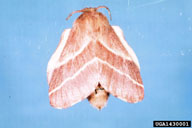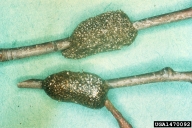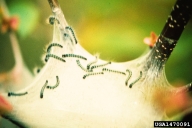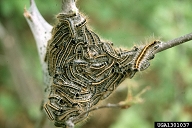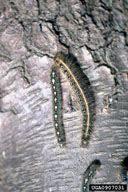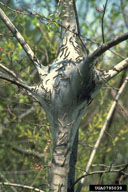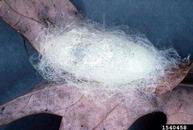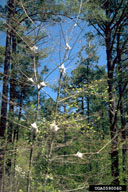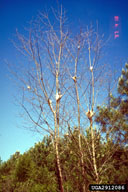Eastern tent caterpillar
Malacosoma americanum (F.) (Lepidoptera: Lasiocampidae)
Orientation to pest
Eastern tent caterpillar, Malacosoma americanum (F.), occurs throughout southern Canada and the eastern United States and is a defoliator that feeds on a variety of hardwood trees, especially cherry (Prunus) and apple (Malus). Winter is passed as eggs, which hatch in spring. Larvae begin feeding on buds and expanding leaves. Older larvae feed on mature leaves. Larvae lay silk trails that they follow to foliage, where they feed in groups. When not feeding, larvae shelter in silk tents constructed low in trees in the forks of branches. Mature larvae wander and pupate inside a yellowish-white cocoon fixed to the host tree or other objects. Adults emerge in midsummer (north) or spring (south) and lay their eggs in clusters that encircle twigs of the host trees. Eggs are cemented together and covered with dark colored material called spumaline. There is one generation per year. This species is primarily a nuisance species, causing little economic loss, with the exception of black cherry (Prunus serotina Ehrh.) stands managed to produce veneer wood. The tents of this species are commonly seen along roadsides on young cherry or apple. Caterpillars that have fed on cherry, if then eaten by horses, can cause mares to abort making this pest of special concern in areas dedicated to rearing race horses.
Hosts commonly attacked
This species is a generalist defoliator on a variety of hardwood trees, especially cherry (Prunus) and apple (Malus).
Distribution
This species occurs throughout southern Canada and the eastern United States.
Images of eastern tent caterpillar
| Figure 1. Adult of eastern tent caterpillar, Malacosoma americanum | Figure 2. Egg masses of eastern tent caterpillar | Figure 3. Young larvae of forest tent caterpillar on a small web |
| Figure 4. Large larvae of eastern tent caterpillar | Figure 5. Close up of eastern tent caterpillar larva | Figure 6. Comparison of caterpillars of eastern tent caterpillar (right) and forest tent caterpillar (left) |
| Figure 7. Close up of eastern tent caterpillar tent with mature larvae | Figure 8. Eastern tent caterpillar cocoon (with pupa inside) | Figure 9. Webs of eastern tent caterpillar on defoliated trees |
Important biological control agents related to this pest species
A variety of natural enemies of this species have been recognized. See Van Driesche et al. (2002) for details. However, their importance in determining the density of this species has not been investigated.
Web links for information on eastern tent caterpillar
- Fact Sheet | UK Entomology, University of Kentucky
- Fact Sheet | Ohio State University Extension
- Invasive Insects Fact Sheet |
New York Department of Environmental Conservation
Discusses Forest Tent Caterpillar), Eastern Tent Caterpillar, and Gypsy Moth - Time Lapse Video on Youtube |
Cornell University Cooperative Extension
Shows eastern tent caterpillar web construction and feeding - Species Recognition and Habits Guide | L.L. Hyche, Auburn University
Articles
- Progar, R. A., M. J. Rinella, D. Fekedulegn, and L. Butler. 2010. Nuclear polyhedrosis virus as a biological control agent for Malacosoma americanum (Lepidoptera: Lasiocampidae). Journal of Applied Entomology 134: 641-646.
- Haynes, K. F., J. McLaughlin, S. Stamper, C. Rucker, F. X. Webster, D. Czokajlo, and P. Kirsch. 2007. Pheromone trap for the eastern tent caterpillar moth. Environmental Entomology 36: 1199-1205.
- Crump, D., R. M. Silverstein, H. J. Williams, and T. D. Fitzgerald. 1987. Identification of trail pheromone of larva of eastern tent caterpillar Malacosoma americanum (Lepidoptera: Lasiocampidae). Journal of Chemical Ecology 13: 397-402.
- VanDriesche, R, G., S. Healy, and R. C. Reardon. 2002. Biological Control of Arthropod Pests of the Northeastern and North Central Forests in the United States. A review and recommendations. FHTET-96-19. USDA Forest Service, Morgantown, West Virginia.
Viewable at http://www.fs.fed.us/foresthealth/technology/pdfs/FHTET_96_19.pdf
